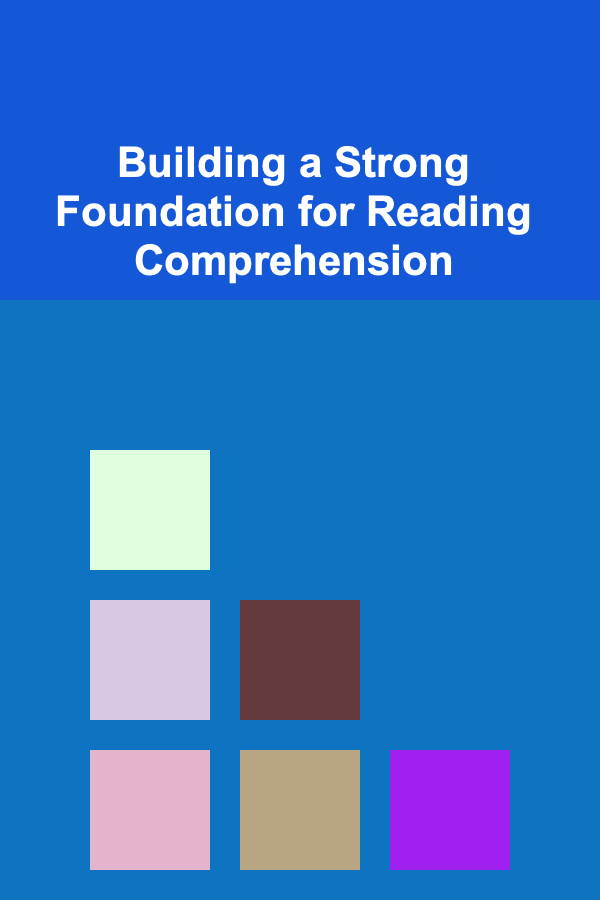
Building a Strong Foundation for Reading Comprehension
ebook include PDF & Audio bundle (Micro Guide)
$12.99$9.99
Limited Time Offer! Order within the next:

Reading comprehension, the ability to understand and extract meaning from written text, is a cornerstone of academic success, professional development, and informed citizenship. It's more than just decoding words; it's about engaging with the text, connecting ideas, and drawing inferences. A strong foundation in reading comprehension empowers individuals to learn effectively, think critically, and communicate persuasively. This article explores the multifaceted nature of reading comprehension and provides a comprehensive guide to building and strengthening this crucial skill.
Understanding the Layers of Reading Comprehension
Reading comprehension isn't a single skill, but rather a complex interplay of several cognitive processes working in concert. To effectively build a foundation, it's essential to understand these underlying layers:
- Decoding: This is the foundational skill of translating written symbols into spoken words. It involves phonological awareness, phonics, and fluency. While crucial, decoding is only the first step. A student can decode perfectly yet still fail to comprehend the meaning.
- Vocabulary: A robust vocabulary is essential for understanding the meaning of individual words and their nuances within the context of a sentence or paragraph. A limited vocabulary acts as a bottleneck, hindering the flow of comprehension.
- Sentence Comprehension: This involves understanding the grammatical structure of sentences (syntax) and how words relate to each other to form a coherent meaning. Students need to understand how subjects, verbs, objects, and modifiers function within a sentence.
- Paragraph Comprehension: Moving beyond individual sentences, this layer focuses on understanding the main idea of a paragraph, identifying supporting details, and recognizing the relationships between sentences. Understanding paragraph structure (e.g., topic sentence, supporting details, concluding sentence) is critical.
- Text Comprehension: This encompasses understanding the overall meaning of the entire text, identifying the author's purpose, recognizing the tone, drawing inferences, making connections to prior knowledge, and critically evaluating the information presented. This requires synthesizing information from multiple paragraphs and understanding the overall structure of the text (e.g., narrative, expository, persuasive).
- Critical Thinking: This is the highest level of reading comprehension and involves analyzing the text, evaluating the author's arguments, identifying biases, and forming independent judgments. It requires going beyond the surface level of the text and questioning the assumptions and evidence presented.
Building Blocks: Strengthening Foundational Skills
Before tackling complex texts, it's crucial to ensure that foundational skills are firmly in place. Here are some strategies for strengthening these building blocks:
Decoding Skills
- Phonological Awareness Activities: Engage in activities that develop awareness of sounds in spoken words, such as rhyming, blending, segmenting, and manipulating phonemes. Examples include identifying the first sound in a word, blending sounds to form a word, and breaking a word down into its individual sounds.
- Phonics Instruction: Provide systematic and explicit phonics instruction that teaches the relationships between letters and sounds. This should include teaching letter-sound correspondences, blending sounds to decode words, and segmenting words to spell them.
- Fluency Practice: Encourage repeated reading of familiar texts to improve reading rate, accuracy, and prosody. Choral reading, partner reading, and audio-assisted reading are effective fluency-building techniques. Focus on reading with expression and understanding, not just speed.
Vocabulary Development
- Wide Reading: Encourage reading a variety of genres and texts to expose students to new vocabulary in context. The more they read, the more words they'll encounter and internalize.
- Explicit Vocabulary Instruction: Teach new words explicitly, focusing on their meanings, origins (etymology), and usage. Use visual aids, real-world examples, and context clues to help students understand and remember new words.
- Context Clues: Teach students how to use context clues (e.g., definitions, synonyms, antonyms, examples) to determine the meaning of unfamiliar words. Provide opportunities to practice using context clues in different texts.
- Morphemic Analysis: Teach students to recognize and understand common prefixes, suffixes, and root words. This knowledge can help them decode the meaning of unfamiliar words. For example, understanding the prefix "pre-" can help students understand words like "prehistoric," "prejudice," and "prepare."
- Vocabulary Games: Make vocabulary learning fun and engaging by incorporating games such as crossword puzzles, word searches, and vocabulary bingo.
- Word Walls: Create word walls in the classroom or home to display and review newly learned vocabulary.
Sentence Comprehension
- Sentence Diagramming: While perhaps considered old-fashioned, sentence diagramming can be a valuable tool for visually representing the structure of sentences and understanding the relationships between words.
- Sentence Combining: Provide opportunities for students to combine simple sentences into more complex sentences. This helps them understand how phrases and clauses function to create more nuanced meanings.
- Sentence Deconstruction: Teach students how to break down complex sentences into smaller, more manageable parts to understand their meaning. This involves identifying the subject, verb, and other key elements of the sentence.
- Identifying Sentence Types: Help students recognize different types of sentences (e.g., declarative, interrogative, imperative, exclamatory) and how they function differently.
Strategies for Enhancing Reading Comprehension
Once a solid foundation is in place, the focus shifts to actively engaging with the text and employing strategies that promote deeper understanding. Here are some effective techniques:
Before Reading Strategies
- Activating Prior Knowledge: Connect the topic of the text to students' existing knowledge and experiences. Ask questions like "What do you already know about this topic?" or "Have you ever experienced something similar?" This creates a framework for understanding the new information.
- Previewing the Text: Skim the title, headings, subheadings, and images to get a general sense of the text's content and organization. This helps students anticipate what they will be reading and focus their attention accordingly.
- Setting a Purpose for Reading: Establish a clear purpose for reading the text. Ask questions like "What do you want to learn from this text?" or "What are you hoping to find out?" Having a purpose helps students stay focused and engaged.
- Making Predictions: Encourage students to make predictions about what the text will be about based on the title, headings, and other cues. This activates their thinking and prepares them to engage with the text actively.
During Reading Strategies
- Active Reading: Encourage students to actively engage with the text by highlighting key information, underlining important points, and writing notes in the margins. This helps them stay focused and process the information more effectively.
- Asking Questions: Encourage students to ask questions about the text as they read. These questions can be about vocabulary, concepts, or the author's intentions. Answering these questions helps deepen understanding.
- Visualizing: Encourage students to create mental images of the scenes, characters, and events described in the text. This helps them connect with the text on a deeper level and remember the information more easily.
- Making Connections: Encourage students to make connections between the text and their own experiences, other texts they have read, and the world around them. This helps them understand the text in a broader context.
- Monitoring Comprehension: Teach students to monitor their own comprehension as they read. They should ask themselves questions like "Do I understand what I just read?" or "Does this make sense?" If they are struggling, they should try rereading the passage, looking up unfamiliar words, or asking for help.
After Reading Strategies
- Summarizing: Ask students to summarize the main points of the text in their own words. This helps them consolidate their understanding and identify the key information.
- Retelling: Ask students to retell the story or explain the concepts in their own words. This helps them practice their comprehension and communication skills.
- Answering Questions: Provide students with questions about the text to check their comprehension. These questions should cover a range of comprehension skills, such as identifying the main idea, understanding supporting details, making inferences, and evaluating the author's purpose.
- Discussing the Text: Facilitate discussions about the text to encourage students to share their thoughts and interpretations. This helps them learn from each other and develop their critical thinking skills.
- Writing Responses: Ask students to write responses to the text, such as essays, reports, or creative writing pieces. This helps them process the information and express their understanding in a meaningful way.
The Role of Motivation and Engagement
Even with strong foundational skills and effective strategies, reading comprehension can suffer if students are not motivated and engaged. Creating a positive reading environment is crucial.
- Choice: Allow students to choose books and texts that interest them. This increases their motivation and engagement. A well-stocked classroom library is invaluable.
- Relevance: Connect reading material to students' lives and interests. Show them how reading can be relevant to their personal goals and aspirations.
- Purposeful Activities: Design reading activities that are meaningful and engaging. Avoid rote tasks and focus on activities that require critical thinking and problem-solving.
- Positive Reinforcement: Provide positive feedback and encouragement to students to build their confidence and motivation. Celebrate their successes and help them learn from their mistakes.
- Creating a Reading Community: Foster a classroom culture that values reading and encourages students to share their reading experiences with each other. Book clubs, author visits, and reading aloud can all contribute to a positive reading community.
Addressing Specific Challenges in Reading Comprehension
Some students face specific challenges that require targeted interventions. Identifying these challenges and implementing appropriate strategies is crucial for supporting their reading comprehension development.
Learning Disabilities
Students with learning disabilities, such as dyslexia, may struggle with decoding, fluency, and other foundational reading skills. These students may benefit from:
- Multisensory Instruction: Employ teaching methods that engage multiple senses (e.g., visual, auditory, kinesthetic) to help students learn and remember information.
- Structured Literacy Programs: Utilize structured literacy programs that provide systematic and explicit instruction in phonics, phonological awareness, and other essential reading skills.
- Assistive Technology: Provide access to assistive technology, such as text-to-speech software, to help students overcome reading barriers.
- Individualized Instruction: Provide individualized instruction tailored to the student's specific needs and learning style.
English Language Learners (ELLs)
ELLs may face challenges understanding the vocabulary, grammar, and cultural references in English texts. These students may benefit from:
- Pre-teaching Vocabulary: Introduce key vocabulary words before reading the text to help ELLs understand the meaning of the text.
- Providing Visual Aids: Use visual aids, such as pictures, diagrams, and graphic organizers, to support comprehension.
- Simplifying Language: Modify the language of the text to make it more accessible to ELLs. This may involve using simpler vocabulary, shorter sentences, and more direct language.
- Cultural Sensitivity: Be aware of the cultural backgrounds of ELLs and select texts that are culturally relevant and appropriate.
- Bilingual Support: Provide bilingual support, such as bilingual dictionaries and translated materials, to help ELLs understand the text.
Students with Attention Deficit Hyperactivity Disorder (ADHD)
Students with ADHD may struggle to focus and maintain attention while reading. These students may benefit from:
- Breaking Down Tasks: Divide reading tasks into smaller, more manageable chunks to help students stay focused.
- Providing Frequent Breaks: Allow students to take frequent breaks to move around and refocus their attention.
- Creating a Quiet Environment: Provide a quiet and distraction-free environment for reading.
- Using Active Reading Strategies: Encourage students to use active reading strategies, such as highlighting, underlining, and note-taking, to stay engaged with the text.
- Providing Positive Reinforcement: Provide positive reinforcement and encouragement to students to build their confidence and motivation.
The Long-Term Benefits of Strong Reading Comprehension
Investing in building strong reading comprehension skills yields significant long-term benefits that extend far beyond the classroom. Individuals with strong reading comprehension are better equipped to:
- Succeed Academically: Reading comprehension is essential for success in all academic subjects, from literature to science to mathematics.
- Pursue Higher Education: Strong reading comprehension is critical for college success and beyond.
- Enter the Workforce: Reading comprehension is a valuable skill in virtually every profession.
- Be Informed Citizens: Reading comprehension is essential for understanding current events, evaluating information, and participating in civic life.
- Become Lifelong Learners: Reading comprehension enables individuals to learn new things throughout their lives and adapt to a changing world.
- Enhance Personal Growth: Reading comprehension opens up a world of possibilities for personal growth and enrichment.
Conclusion: A Lifelong Journey
Building a strong foundation for reading comprehension is a lifelong journey, not a destination. It requires a comprehensive approach that addresses foundational skills, employs effective strategies, fosters motivation, and provides targeted support for students with specific challenges. By investing in reading comprehension development, we empower individuals to become lifelong learners, critical thinkers, and engaged citizens. The ability to comprehend, analyze, and synthesize information from written text is an invaluable asset in today's complex and information-rich world. It is an investment that pays dividends in academic achievement, professional success, and personal fulfillment.

How to Maintain the Efficiency of Your Dishwasher
Read More
How to Stage Your Home to Attract First-Time Buyers
Read More
Setting Achievable Goals for Your Job Search Journey
Read More
How to Use Networking to Generate Profit
Read More
How to Manage Sports Performance Anxiety
Read More
How to Achieve a Bouncy Blowout at Home
Read MoreOther Products

How to Maintain the Efficiency of Your Dishwasher
Read More
How to Stage Your Home to Attract First-Time Buyers
Read More
Setting Achievable Goals for Your Job Search Journey
Read More
How to Use Networking to Generate Profit
Read More
How to Manage Sports Performance Anxiety
Read More